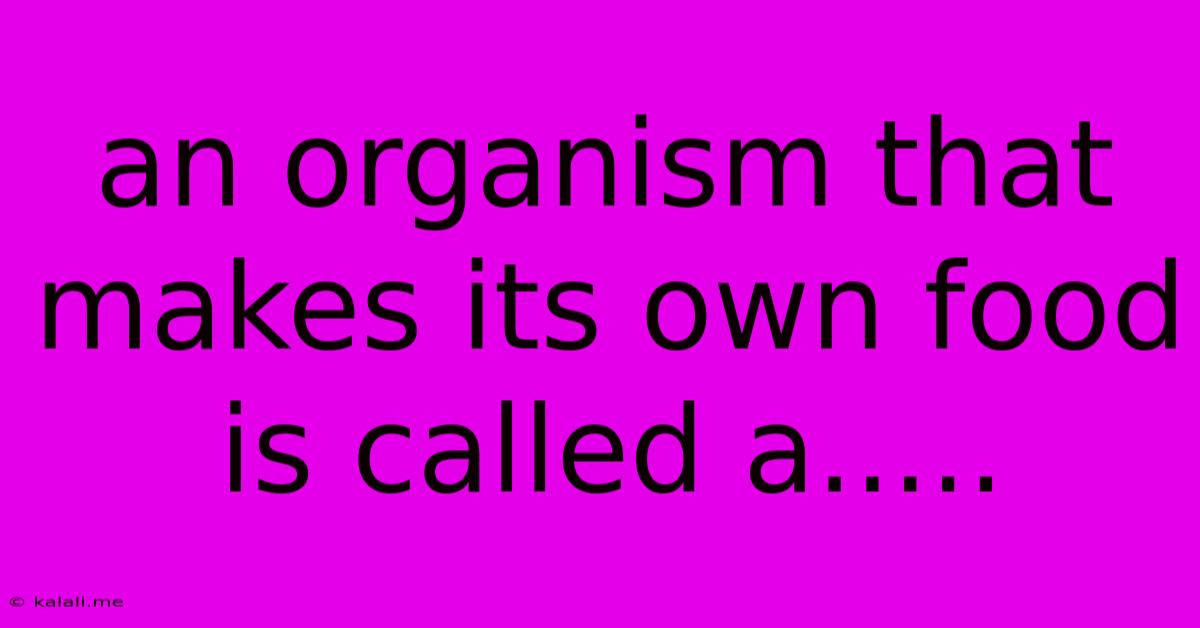An Organism That Makes Its Own Food Is Called A.....
Kalali
May 09, 2025 · 3 min read

Table of Contents
An Organism That Makes Its Own Food Is Called a... Producer!
An organism that makes its own food is called a producer, also known as an autotroph. This crucial role within an ecosystem defines the base of the food chain, supporting all other life forms. Understanding producers and their processes is fundamental to grasping the complexities of biology and ecology. This article will delve into the fascinating world of autotrophs, exploring their mechanisms, types, and importance in maintaining the delicate balance of nature.
Producers are the primary source of energy in most ecosystems. They convert inorganic substances into organic compounds, a process primarily driven by sunlight in a process called photosynthesis. This energy is then passed on to consumers – herbivores, carnivores, and omnivores – higher up the food chain. Without producers, the intricate web of life as we know it would collapse.
How Do Producers Make Their Own Food?
The most common method of food production in producers is photosynthesis. This remarkable process utilizes sunlight, water, and carbon dioxide to create glucose (a simple sugar) and oxygen. The glucose serves as the producer's primary source of energy and building blocks for growth and development. The chemical equation for photosynthesis is famously summarized as:
6CO₂ + 6H₂O + Light Energy → C₆H₁₂O₆ + 6O₂
This process occurs within specialized organelles called chloroplasts, containing chlorophyll, the green pigment that absorbs sunlight. Different types of producers possess various adaptations to optimize their photosynthetic efficiency in diverse environments.
Different Types of Producers
While photosynthesis is the most prevalent method, not all producers use sunlight. Producers can be categorized into two main groups:
-
Photoautotrophs: These utilize light energy to synthesize food. This includes plants, algae, and cyanobacteria (blue-green algae). These organisms are the foundation of most terrestrial and aquatic food webs.
-
Chemoautotrophs: These organisms, unlike photoautotrophs, don't rely on sunlight. Instead, they obtain energy from chemical reactions, primarily involving the oxidation of inorganic compounds like hydrogen sulfide or ammonia. Chemoautotrophs are typically found in extreme environments like deep-sea hydrothermal vents and are vital to these unique ecosystems. Examples include certain bacteria and archaea.
The Importance of Producers in the Ecosystem
Producers are essential for several reasons:
-
Base of the Food Chain: They provide the primary source of energy for all other organisms. Herbivores consume producers directly, while carnivores and omnivores indirectly obtain energy by consuming herbivores.
-
Oxygen Production: Photosynthetic producers release oxygen as a byproduct of photosynthesis, a crucial gas for the respiration of most organisms. This process has shaped the Earth's atmosphere over billions of years.
-
Carbon Cycle Regulation: Producers play a vital role in the carbon cycle by absorbing carbon dioxide from the atmosphere during photosynthesis. This helps regulate atmospheric carbon dioxide levels and mitigate climate change.
-
Habitat Provision: Many producers, such as plants and algae, provide habitats and shelter for a diverse array of organisms. Forests, grasslands, and coral reefs are all examples of ecosystems built around producers.
In conclusion, an organism that makes its own food is called a producer, a vital component of any ecosystem. Whether through photosynthesis or chemosynthesis, producers form the base of the food web, generating energy and oxygen, and maintaining the delicate balance of life on Earth. Their significance underscores the interconnectedness of all living things and the importance of preserving biodiversity to protect these foundational organisms.
Latest Posts
Related Post
Thank you for visiting our website which covers about An Organism That Makes Its Own Food Is Called A..... . We hope the information provided has been useful to you. Feel free to contact us if you have any questions or need further assistance. See you next time and don't miss to bookmark.